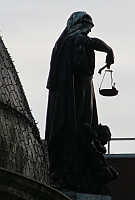
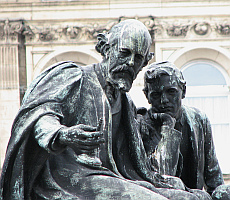
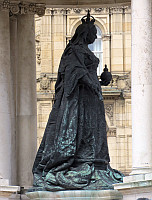
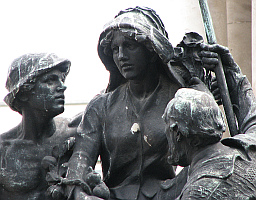
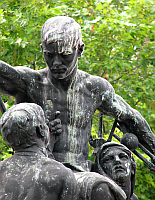
The Queen Victoria Monument in Derby square, Liverpool, feels a bit out of the way and neglected, but here we have an important monument of turn of the century sculpture (it was unveiled in 1906), and indeed, in a hierarchy of commemorative monuments in Britain, it ranks high in terms of numbers of sculptural groups and overall size. The central figure of Queen Victoria stands beneath a dome, surrounded by four groups of clustered pillars, each bearing at the top an allegorical group, with a summit figure of Victory. The whole stands raised on a series of steps, and at the bottom of these are raised four pedestals, each bearing a larger group. Heavy double handled pots and plaques complete the ensemble. The architecture is white fossiliferous limestone, the figures, groups, pots and plaques are a satisfying contrast in blackened bronze.
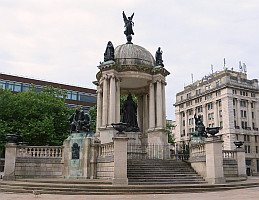
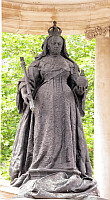
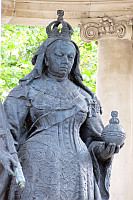 Complete monument, and statue of Queen Victoria.
Complete monument, and statue of Queen Victoria.
The sculptor was C. J. Allen, an important and prolific artist with a fondness for allegory and imaginary subjects, and in this grand monument in his home town, his magnum opus, he made full use of the different elements of the monument to follow his natural inclinations.
The figure of the Queen is unsentimental, indeed unflattering, but is instantly recognisable and does have something of a presence. She is shown in her later years. The artist was at pains with the ornamentation on her richly pattered dress, her hanging sleeves and her heavy cloak, the folds of which bunch up at the base of the statue and in front of it, somewhat reminiscent of waves, which is entirely appropriate.
Agriculture, Commerce, Industry and Education groups.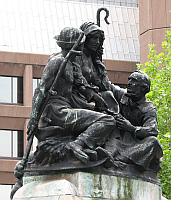
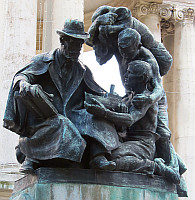
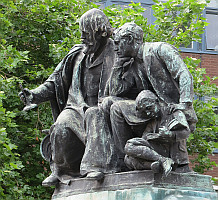
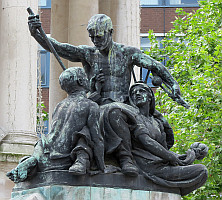
The pedestal groups comprise Agriculture, Commerce, Industry and Education.. All are excellent. It is easy to overlook the easy superposition of modern Victorian garbe with Classical drapery, and the compositions are full of pleasing swirls and lines that bind the groups together, as shown above. They also have many accoutrements: for example in the Agriculture group, the central female figure holds a flowering and a fruiting branch, while the youthful figure to the foreground in our picture carries a scythe and has a sheaf of corn at his feet, and the elderly shepherd on the other flank holds his long crook. This website contains lots of allegorical statues; click for links to Agriculture, Industry and Education.
Upper groups: Charity, Justice, Peace and Wisdom.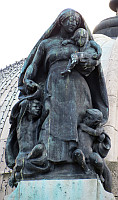
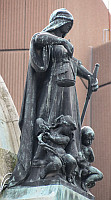
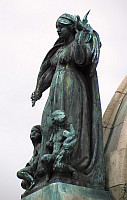
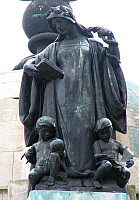
The smaller allegorical groups atop the pillars consist of tall, heavily draped female figures with small nude infants or putti. The cowled figure of Justice is one of the most menacing, grim Justice figures I have seen (several more on this page). In contrast is the charming figure representing Wisdom, a subtle, beautiful maiden who is unfortunately too high to appreciate fully without binoculars. She reads a book and carries a snake, symbol of both Wisdom and Medicine (see this page), and one of the infants at her feet carries a globe and callipers, indicative of Science and Measurement, while the other holds a scroll.
Finally the summit figure. She is lightly draped in Hellenistic fashion to show the figure, but there is nothing Greek about her soft arms and 1900s face. An excellent statue in all regards. For more statues of Fame, see this page.
Altogether then, an exquisite monument, and it is a shame that it is not made more of – what a contrast with the national Victoria Monument in front of Buckingham Palace. Definitely all those who come to Liverpool should make sure to see this work.
Castle Street // St John's Gardens, behind St George's Hall // Statues on eastern side of St George's Hall // // Other sculpture in Liverpool
Sculpture pages // C. J. Allen
Visits to this page from 23 Nov 2011: 3,038 since 10 September 2024